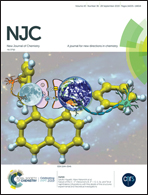The construction of ZnS–In2S3 nanonests and their heterojunction boosted visible-light photocatalytic/photoelectrocatalytic performance†
Abstract
The photocatalytic/photoelectrocatalytic performance of nanomaterials can be enhanced by engineering a purposely designed heterojunction and a finely tuned interface electronic structure. In this featured study, we report a kind of slack ZnS–In2S3 nanonest constructed with uniform nanowires consisting of very tiny nanoparticles. Its unique microstructure created abundant heterojunctions and significantly enhanced the photocatalytic/photoelectrocatalytic performance of ZnS–In2S3 under visible light. As a photoelectrocatalyst, the ZnS–In2S3 heterojunction delivered a photocurrent density of 180 μA cm−2 at 1.23 V (vs. RHE), which is 1.5 times higher than that of pure In2S3 and far higher than that of ZnS. As a photocatalyst, the ZnS–In2S3 nanonest can completely degrade methyl orange (MO) in 20 min, which is much faster than that by pure ZnS and In2S3 under visible light. The average apparent rate of the ZnS–In2S3 heterojunction nanonest is almost four times higher than that of pure In2S3. These remarkable performances are attributed to the unique ZnS–In2S3 heterojunction, which could decrease the average free path of charge carriers and improve the charge separation efficiency.



 Please wait while we load your content...
Please wait while we load your content...